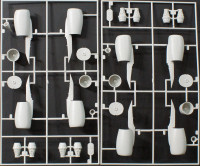
ESCI/ERTL 1/72 KC-135R Stratotanker Kit First Look
By Michael Benolkin
| Date of Review | August 2014 | Manufacturer | ESCI/ERTL |
|---|---|---|---|
| Subject | KC-135R Stratotanker | Scale | 1/72 |
| Kit Number | 8909 | Primary Media | Styrene |
| Pros | Best kit of this subject in any scale | Cons | See text |
| Skill Level | Experienced | MSRP (USD) | Out of Production |
First Look
 |
 |
In the early 1980s, the U.S. Air Force began a comprehensive update to their fleet of C-135-based airframes. While Reserve and Air Guard tankers received refurbished TF-33 engines from surplus 707 airliners, another modification program was also underway. The CFM-56 high-bypass fan engine was not only powering a growing fleet of Airbus aircraft, it was also the engine adopted for the Boeing 737 replacing the JT8D (J52) turbojet engine. The CFM-56 was also finding its way to older aircraft such as the DC-8 Super 80 cargo aircraft which greatly enhanced the capabilities of that airframe. The Air Force wanted to re-engine the active duty C-135 fleet with the F108 (U.S. military designation for the CFM-56) .
Conversion of the C-135 airframe was straightforward with updated cockpit control modules, new engines on near-horizontal pylons, and a new APU system in the rear of the aircraft. Designated as KC-135R, the F108 engine produces as much power as two J57 engines that originally powered this airframe. One of the disadvantages of the F108 engines is ground clearance. Even with similar horizontal pylon beams as the later 737s, the F108/CFM-56 engines are close to the ground making FOD ingestion a greater concern. Cross-wind landings are also a concern because with the KC-135A/E, your wingtip will likely hit the runway before your outboard engine pod, but with the KC-135R you've got to keep the wings level near the ground to avoid a pod-strike. KC-135R crews have become proficient in crab landings.
I recently acquired a number of C-135/707 kits in 1/72 and thought it might be worth a look at these kits given that they are still available at kit swaps and a periodic release. This release is the KC-135R circa 1980/90s. The kit is based upon the KC-135A kit we examined previously but replaces the J-57 engine sprues with these two F108/CFM-56 sprues. Please follow the link above to see the complete KC-135A parts images. Among the features and options in this release:
- Nicely detailed cockpit complete with pilot, copilot, navigator and flight engineer stations
- Detailed cargo floor with O2 bottle stowage
- Positionable crew entry hatch with ladder
- Positionable cargo door
- Detailed wheel wells and landing gear
- Detailed refueling pod with couches
- Positionable boomer window hatch
- Positionable air refueling boom
- Optional hose and droque attachment
- New APU fuselage fairing
- Nice F108 engine pods
Where the ESCI/ERTL KC-135A and AMT/ERTL RC-135V featured Scalemaster Decals, this release had decals from 'the lowest bidder' and they aren't aging as gracefully as the Scalemaster Decal sheets. There are two subjects included in this release:
- KC-135R, 62-3569, 'Sky Runner'
- KC-135R, 62-3554, 'Cherokee Rose'
There are lots of details and possibilities in this kit, but do note that one of ESCI/ERTL's and AMT/ERTL's common kit 'features' is the use of a soft styrene for their kits. You may not notice it right away, but larger kits like this C-135 series and their B-52 series will start to sag over time. I've see a few of these beauties hanging up in different collections and the wings start to sag. The fix is easy - install a Plastruct styrene I-beam or L-beam as a mainspar in each wing and there will be no sag. The spar will also reinforce that overlapping upper/lower wing joint.
If you have the KC-135A, RC-135V, and this kit, you have all three engine sets for the -135 airframe. This provides some interesting mix and match possibilities such as backdating the KC-135R with the J-57 engines (KC-135A) or TF-33 engines to render the KC-135E (for example). With all of the variants of this aircraft that have served and many of which continue to serve today, you have lots of possibilities to create something distinctive on the contest table!
Once upon a time, kits as large as these were widely available but not that popular just due to their sheer size in the box as well as built-up. These days however, this kit is not that large given the growing trend of 1/32 scale kits out there. If you've got one of these stashed away, perhaps it is time to dust it off and give it a try. If you don't Italeri has been reissuing this kit in USAF markings as well as French (KC-135FR).







